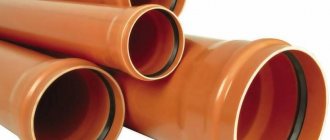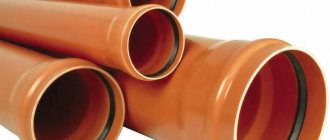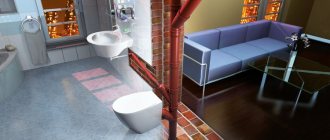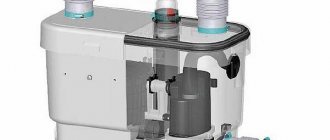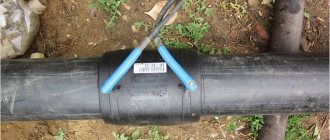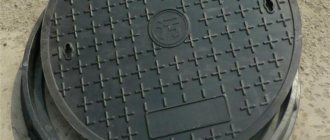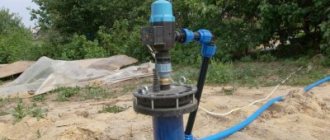Sealing with rubber seals
Rubber seals for sewer pipes are most often used. They are easy to use, reliable and durable. They are used when installing sewerage systems in country houses and apartments, industrial buildings. The composition of rubber seals includes the following substances:
- rubber compound;
- rubber;
- polyurethane;
- silicone;
- paronitis
The result is durable, elastic rubber seals that ensure tightness and reliability of sewer pipe connections. The products are resistant to temperature changes, aggressive chemicals, non-concentrated acids and alkalis.
Rubber seals are classified depending on their purpose. They can be universal, rod, or piston. Three-lobe seals ensure a smooth transition from a cast iron pipe to a plastic one.
Rubber cuffs have a number of advantages. They are inexpensive, reliable, durable, and prevent groundwater from entering the sewer system. Thanks to the seal, the wastewater does not escape to the outside, and there is no unpleasant odor in the area.
Types of pipes for drainage
The choice of method and material for sealing is directly related to the type of sewer pipe. For the installation of drainage systems in apartments and private houses, the following are most often used:
- Cast iron pipes. They are mechanically strong, durable, and corrosion resistant. One end is formed in the form of a bell - a funnel-shaped extension, providing a quick and reliable connection.
- Plastic. They are made from polyethylene, polyvinyl chloride, polypropylene, fiberglass. The products are lightweight and heat resistant. Service life reaches 50 years. The inner surface of polymer pipes is smooth, which reduces the deposition of suspended matter. Inexpensive price and simple installation make it possible to widely use polymer products in private construction and for apartment renovations.
Plumbing polymer products for pipeline installation
Ceramic, asbestos or concrete structures are used much less frequently. They are difficult to transport and install due to their heavy weight, and in some qualities they are inferior to their counterparts made of cast iron or polymers.
Practice using cuffs
Using cuffs, plumbing equipment (sinks, sinks, bathtubs, toilets, etc.) and household appliances (washing machines, dishwashers) are connected to the sewer network, and sewer pipes are connected. Plastic is connected to plastic using special fittings equipped with rubber sealing rings, and cast iron is connected to plastic using either adapters, couplings, or just cuffs.
To join cast iron and plastic pipes, both external and internal cuffs are used (for socketed and socketless structures). They work in stages:
- clean the connecting part of the cast iron pipe - it must be absolutely clean to ensure proper adhesion of the sealant;
- apply sealant to the cuff and insert it into the socket;
- A plastic pipe is inserted into the cuff.
If pipes have to be cut, this must be done correctly - the cut must be smooth (no nicks, even if they seem microscopic and are difficult to detect). After cutting, the part is chamfered.
In terms of the procedure for joining smooth pipes, it is not much different from socket pipes - the sealant must be applied to the collar on both sides, since the coupling is placed on top of it.
Scheme for installing a cuff on a sewer pipe (connection of smooth pipes)
Siphon connection
For this purpose, the use of a sealing collar is mandatory (there is always water in the siphon - it serves as a kind of seal). There are no difficulties in connecting the siphon - you can easily do it yourself without any special knowledge. First, the siphon itself is assembled according to the instructions (the accompanying documentation must be available, otherwise you should not buy the equipment: the configuration is different, and the assembly instructions vary accordingly). Then connect the pipe:
- to the siphon;
- to the sewer (simply inserted into the fitting hole intended for this purpose).
If the fitting on the riser is equipped with an O-ring, the collar is used only to connect the pipe to the siphon.
Types of sealants
Sealing of sewer pipes can be done with the following materials:
- reinforced aluminum adhesive tapes;
- silicone sealants;
- mastics from various manufacturers;
- polymer cement solutions;
- sanitary winding;
- epoxy resin;
- technical sulfur.
To choose the right sealant for sewer pipes, you need to know the material from which the drain is made. Silicone compounds and reinforced tapes are suitable for lightweight plastic pipes PVC, PEX, HDPE, etc. If you have to work with metal (steel or cast iron), you need to use something serious. It is also important to consider for what work the solution is purchased.
The joints of PVC plastic pipes are sealed with lightweight silicone, which is unlikely to cope with an emergency leaking sewer. It is also important to follow the instructions. It describes the optimal conditions under which sewer pipes should be sealed. For example, let's take the optimal conditions for curing silicone sealant (this is room temperature, at which it dries for about 4 minutes). When working in cold weather, the hardening time is significantly longer.
There is a need to purchase another type of sealant - frost-resistant silicone. We'll talk about the nuances of using different materials below.
What is needed to organize internal sewerage
The internal sewer system collects wastewater from throughout the house and discharges it into the riser.
Sewerage accessories include:
- water seals connecting plumbing fixtures to the pipeline;
- a pipeline that discharges wastewater from the floor into the collector;
- ventilation tube;
- actually, the riser itself;
- sewer bed - a horizontal section of the pipeline through which wastewater flows further from the riser.
When laying pipes, you will need such shaped elements as revisions, tees, elbows, plugs, etc. Without them, it is impossible to ensure drainage according to all the rules.
Shaped elements
Shaped parts for sewerage can otherwise be called connecting parts; they are produced in the following configurations:
coupling - a short piece of pipe with sockets on both sides. Used to connect 2 parts of the pipeline;
adapter (reduction) – used to connect pipes of different diameters. Reduction can be coaxial or eccentric;
tee - this element is indispensable in situations where you need to create a branch extending from the main sewer system, for example, when laying out floors with your own hands;
revision - the same tee, only the outlet is closed with a plug, and the branch itself is small. Used when the sewer is clogged to clean it;
crosspiece - the purpose is the same as that of a tee, but with its help a more complex unit is organized;
- elbow
(bend) – used when turning the pipeline; - non-return valve
- necessary in emergency situations, thanks to it wastewater will not flow back in the event of a malfunction of the drainage system;
plug - during repairs, used to block the sewer.
Sewer fittings are a vital element when laying out the system. Without them, it is impossible to install pipes across the floor or connect them to the riser.
Features of connecting plumbing fixtures
The connection of any plumbing fixture must be organized so that unpleasant odors from the sewer do not leak into the room. The simplest method is to connect through a water seal (or siphon).
The siphon looks like an ordinary pipe in the shape of the letter S, thanks to the water plug, protection against odors is guaranteed. If you do not plan to live in the house regularly, for example, in a country house, then you can consider other methods of protection against odors (dry sewer siphon).
Sewer repair
When repairing the above elements will not be enough. In particular, when replacing a section of a pipeline, sewer pipes will be needed.
There are often situations when part of the old pipe is rotten or simply cracked; in this case, it will be necessary to replace not the entire drainage system, but only a small section. In order to connect the new pipe to the existing drainage system, pipes are used.
Externally, the sewer pipe looks like a small section of pipe, on one side it is smooth, and on the other there is a socket. Accordingly, on the one hand, the connection is made using a socket method, on the other - in a joint, using a coupling.
Sometimes, when repairing an old cast-iron sewer, it is necessary to join plastic and cast-iron pipes. At the same time, to achieve the required tightness, one sealant is not enough. First, you will need to insert a rubber cuff into the cast-iron socket and then a plastic pipe into it.
Tightness of the junction of plumbing fixtures and pipelines
A sewer seal is used to reduce the likelihood of leaks in the area between the plumbing fixture and the pipeline. Externally, the cuff looks like a rubber ring that is placed over the joint.
To achieve greater elasticity, the cuffs do not contain polymers; only natural rubber is used for their production. True, during operation, because of this, it is necessary to use lubricant so that the rubber does not crack.
If you plan to use a rubber cuff, you will also need lubricant for sewer pipes. If you try to insert the end of the pipe into the cuff without lubrication, the rubber can be easily damaged. And after installation, the cuff must be periodically lubricated.
As for the specific lubricant, there are many options, some prefer to use automotive lubricant, which is used for rubber inserts in car doors in the winter. But even ordinary plumbing lubricant can keep the rubber safe and sound.
Installation features
There are two ways to install seals. The choice depends on the availability of a cast iron socket.
If the sewer pipes are in good condition:
- Using a chisel, clear the socket of caulking material and mortar.
- Remove old item.
- Prepare the expansion of the cast iron outlet, remove dirt and wipe with a rag.
- Apply sealant to the outside of the rubber seal and insert it into the socket.
Additionally, there is no need to apply silicone to the outside of the pipeline, since after drying a reliable connection between the elements is formed.
Sealing cuff for external sewerage
In cases where it is not possible to remove old sewer pipes, they are cut off and the edge is made in the form of a cone to ensure easy installation. Since the drainage system in multi-storey buildings is usually active, it is better to choose the morning time for work, when most of the neighbors are at work.
Shut off hot and cold water in the basement to reduce the volume of wastewater. During the preparatory work, the open sewer pipe is plugged with a rag to block access to gases and dirty water. The cut is cleaned of nicks so that in the future they do not cause the formation of garbage plugs.
If there is no bell, use the second method:
- Apply silicone to the inside of the fitting.
- Pull the prepared rubber seal onto the cut end of the cast iron pipe.
- Perform wiring from plastic pipes.
When installing installations, there are times when it is necessary to connect a pipe with a diameter of 90 mm or 95 mm to a conventional cast iron sewer with d 110 mm. In this case, use the Geberit 367928 adapter. It fits perfectly into the cast iron socket, and on the other side allows you to connect a plastic product of a non-standard size. To facilitate installation, liquid soap is applied to the parts. Automotive oil is sometimes used, but it can reduce the performance of the rubber product, reducing its service life.
When connecting 95 mm and 100 mm pipes to a standard sewer, cuffs are used. They can be straight or eccentric. The cast iron pipe has a socket, so the connection will not be tight. In this case, cut a piece of pipe 5 cm long and coat it with liquid soap. Then the resulting ring is put on the product, which already fits tightly into the socket. A product with an eccentric allows you to save space in the bathroom; it is enough to turn it to the desired position, in which the mounting elements are deflected towards the drain pipe.
How to seal pipes
Rubber sealant for sewer pipes is used most often. The sequence of installation work depends on whether the internal or external sewage system is being installed. When arranging an internal pipeline, installation consists of the following steps:
The connection is sealed and the pipeline is now ready for use. It should be remembered that if silicone sealant is used, it should not be applied to the outside of the sewer pipe.
If sealing of the external pipeline is required, installation work is carried out in the following sequence:
- the sealing compound is applied to the inner surface of the rubber cuff;
- the fitting is put on the pipe;
- When the sealant hardens, you can connect the pipeline.
Sealing sewer pipe connections is an important step when performing sewer installation work. It is at the joints that blockages, leaks and other unpleasant problems most often form, which help reduce the service life of the sewer system. You can prevent any problems if you follow the advice of professionals and carry out all work carefully and diligently.
In order for the sewer system to function efficiently and effectively, it must be installed correctly. It’s easier for residents of multi-storey buildings who install only an internal pipeline. But owners of country mansions will have to take care of laying external sewerage and arranging an autonomous system.
Sewage installation consists of several stages:
- drawing up a sewer system project;
- procurement of materials;
- pipe connection;
- sealing joints;
- sealing connections.
Sealing sewer pipes is necessary to avoid leaks and breakthroughs during system operation. Most often, rubber cuffs are used to seal the joints of plastic sewer pipes. Seals prevent water from getting in or out and protect the sewer from the penetration of insects and small rodents. High-quality sealed connections are a guarantee of long-term and efficient functioning of the sewer system.
Varieties
Sealing elements used in pipelines are available in a wide range.
Size
The dimensions of the sealing elements depend on the dimensions of the pipes used for the installation of sewerage systems. The labels indicate two numbers:
- outside diameter;
- inner diameter.
The thickness of the cuff can be easily calculated independently, since it is equal to the difference between the specified parameters. The height of the product is indicated separately. Example: the product label indicates 110 x 124.80. These numbers indicate the size of the cuff, expressed in millimeters.
The first number indicates the internal, and the second - the external diameter. If necessary, you can calculate the width of the product; in our example it is 14 mm. The third number indicates the height of the sealing element.
Purpose
Sealing products are:
- Sealing. These products are used to connect pipes and fittings of the same size.
- Transitional. Without such seals it is impossible to connect elements of different diameters.
Sealing cuffs, in turn, are divided into:
- External. They are put on the smooth end of the pipe.
- Internal. To install this element, a groove is made in the socket.
Advice! In most cases, polymer pipes are sold with internal cuffs already installed in the socket. But to install fittings (for example, crosses), you need to buy cuffs separately.
What types of cuffs are there for sewer pipes?
This is predominantly a round wide o-ring, sometimes with a corrugated part. The cuffs are internal and external. Internal ones are used to connect socket structures, external ones - for smooth pipes (in addition to the seal, a coupling is installed).
Sealing cuffs with corrugated part
Cuffs are most often made of rubber - an elastic material that fits tightly, providing a reliable flexible connection. The shape of a part depends on its function.
Rubber cuffs
Eccentric cuff
The eccentric cuff consists of pipes connected to each other with an offset, that is, the centers of both parts are in different planes. Traditionally, the part is called a cuff, but this is a special shaped part for connecting to the toilet network. It is equipped with O-rings and does not require the use of sealant (with the exception of connection to an old cast-iron riser, when sealant is used for greater reliability, given the difference in materials).
Unfortunately, due to too much displacement of the connected elements, it is not always possible to use the eccentric cuff (although some craftsmen manage to insert one into the other, building a strange structure) - in such cases, the toilet is connected using a corrugation.
Eccentric cuff
The parts come in different configurations, but sometimes such a displacement is required that connection with their help is impossible - in such cases a corrugation is installed.
Pleated cuff
The corrugation is similar to an eccentric cuff, but the implementation of the displacement is different - it is achieved through a flexible corrugated sleeve, and not by positioning the parts relative to each other. Thus, the displacement can be large, but it is necessary to set the desired bending angle of the corrugated part so that the drains flow freely (otherwise blockages are inevitable).
Connection via corrugation
The main advantage of corrugation is flexibility. Thanks to this property of the part, it is almost always possible to connect a toilet to the sewer without errors. The main disadvantage is the short service life. Due to the same flexibility, the walls quickly wear out and the part becomes unusable. When choosing corrugation, you need to give preference to thick-walled, reinforced.
Reinforced corrugation
Installation is theoretically simple (the parts are simply inserted into each other according to the attached instructions), but we do not recommend installing them yourself (unless you have the skills): the cuff functions normally under certain conditions (bending angle, slope, stretch length), and if they are not created, the system will not work will be disrupted (which can lead to floods due to blockages).
So you won’t be able to read a newspaper/memoir while sitting on the toilet, looking out of the window from time to time - or you’ll have to erect a plumbing miracle on a pedestal and screw a ladder to it (here it’s not far from the attic window).
On a pedestal
There is a solution to this problem as well - installing a pumping system that forcibly sends wastewater into the sewer system. However, such drastic changes will require permission for redevelopment, and this is:
- development of a project (yes, just to move the toilet a few meters);
- payment for the project;
- its approval by the authorities and everything related to it;
- payment of the approval fee;
- the commission accepting the transfer of equipment (they look at how far they have moved away from the project, if they have moved away);
- payment of commission fees.
We recommend using the cuffs exclusively for their intended purpose - for connection and nothing more.
Everything is easy in the text - the text cannot convey the effort made. However, we all know what is transported by sewer pipes (that is, what will flood an apartment/house when incorrectly installed cuffs cause a flood), and therefore, when it comes to sewerage, we strongly recommend that you contact specialists, even those with restless hands
Especially when it comes to cast iron risers: cast iron is fragile - it must be handled with extreme caution
How and with what can you seal a sewer pipe?
The sewer system will reliably perform its functions only if its installation ensures that there are no potential leaks. This concerns both the correct laying of pipes and the complete sealing of their joints. Builders usually check whether the sewage system is leaking, and if not, the commission signs an act of acceptance of the facility for operation. But due to wear and tear, sewer pipe joints can leak. How to prevent this phenomenon, and what to do if it does occur?
Sealing a pipe joint with PVC cement
How to install the cuff correctly
The easiest way is to connect a corrugated pipe to a plastic riser. This is due to the specifics of such a joint: it is quite easy to insert an elastic band into the socket, after which the tip of the flexible pipes is placed in the hole.
A more complex option is to connect a plastic riser to a cast iron one. This is due to the fact that for a high-quality joint it is necessary to almost perfectly clean the cast iron socket from old residues of sealants and other possible contaminants.
It is not particularly difficult to join the sewer section of pipes with the presence of internal sealing collars.
The uncut type pipe end easily and simply penetrates into the socket area, in which the seal must first be correctly placed. When a section of the highway is cut, then at its end it is necessary to make a cone-shaped edge, after which the elastic will easily take its place. Plain water can be used as a lubricant.
Risers with a diameter of 110 mm (it is best to buy those manufactured by Rossiya) are more difficult to connect, even if you moisten the joint with water. Therefore, to facilitate the installation of the connecting collar, it must be lubricated with automobile oil and other available lubricants that will facilitate the installation process.
Similarly, it is possible to install valves for differential pressure regulators.
Since our hardware stores have a sufficient number of connecting adapter sleeves for metal, polypropylene, and plastic, it is not particularly difficult to assemble the pipeline hermetically. You just need to correctly determine the internal diameters. After this, connecting cast iron to plastic, plastic to plastic, or making any other connection will not be a problem.
Rubber cuffs for sewerage can be made from different materials, and there are also different types of devices. Hydraulic seals are used in industry, for equipping sewage systems in private houses, cottages and apartments.
Cuffs for cast iron sewers are made of polyurethane and rubber compounds such as rubber, paronite, silicone and rubber. In production, only 100% rubber is used, no polymer is mixed. Thanks to this composition, high elasticity, strength and tightness of fastening with the connected parts are ensured. Polymer and rubber also provide resistance to increases and decreases in temperature, are resistant to aggressive substances, and can be used when exposed to acids and with increased rigidity of working resources.
The sealing cuff for sewerage also comes in different types:
- rod;
- piston;
- universal (for rods and pistons).
Also, the rubber sealing cuff for sewerage can be internal or external. The internal seal is used in cast iron pipes to connect plastic pipes with different diameters. Also used to connect a corrugated hose to the drain of household plumbing fixtures (for example, connecting to the sewage system of a washing machine or dishwasher). The external seal, in turn, is used to connect to a socketless sewer structure.
There is also a three-leaf transitional sewer cuff, which facilitates the transition from a cast iron pipeline to a plastic one.
How to seal cast iron pipes
To connect the riser, you need to insert one cylindrical product made of cast iron into the socket located at the end of the other element. The resulting junction is sealed with a special polymer composition.
The work is carried out by experienced craftsmen in a certain technological sequence.
Ordinary linen tow closes the gap formed between the pipes. The fibers are compacted to a depth of more than 2/3 of the size of the gap and are well compacted.
Next, Portland cement is mixed with water in a ratio of 1:9. The prepared mixture is used to seal the remaining gap in the riser.
The materials described above can be replaced with modern silicone sealant. It is already poured into the existing gap in finished form. To prevent the composition from drying out instantly, the place of its application must first be covered with plastic film.
Elements of external sewerage
In addition to the pipes themselves, revisions and bends, the outer section of the drainage system also includes several specific elements. In the case of an autonomous sewer system, wastewater needs to be stored somewhere while it is being cleaned, so you will need to build a septic tank, or better yet, a septic tank.
Construction of a settling tank
Sewage settling tanks are a regular pit in which wastewater settles, large particles settle to the bottom, after which the clarified wastewater moves to the next stage of treatment. Externally, the sump looks like a pit with reinforced walls and bottom (or a special container).
If the sump is built independently, then the instructions look like this:
- a hole is dug in the ground (depth approximately 2.5 m, cross-section at least 2.0x2.0);
- a cushion of a layer of gravel is poured onto the bottom of the pit, on top of which a sand layer is placed;
- after this you need to seal the bottom and walls of the pit. You can build formwork, place a reinforcement frame in the pit and fill the walls and bottom of the pit with concrete mixture; you can reinforce the walls with brickwork;
when the concrete hardens, all that remains is to concrete the ceiling and arrange ventilation for the sump.
You can go the other way; instead of labor-intensive concreting, many use large-volume plastic containers for sedimentation tanks. These can be Eurocubes, plastic barrels, metal barrels in which paint and varnish materials were previously stored. The price of installing a sump in this case is low, but tightness is ensured.
There are also budget options for settling tanks. From ordinary truck tires, you can build a septic tank suitable for irregularly used sewage systems.
Septic tanks stand apart. Externally, such a container looks like a large barrel with ventilation pipes, and the internal space is divided into separate zones: first, the wastewater settles, then through the overflow system the liquid enters the second section, where final cleaning occurs.
Fluoroplastic pipes and barrels for sewerage
Separately, it is worth mentioning fluoroplastic barrels for sewerage. PTFE itself is an interesting material. Pipes and barrels made from it can be used in the temperature range from -100ᵒС to +250ᵒС. In addition, fluoroplastic is strong and durable.
Note! Fluoroplastic is an inert material; it does not react even with very aggressive substances; in this indicator it even surpasses platinum and gold. Therefore, using it in ordinary sewerage is not entirely justified.
Most often, fluoroplastic pipes and barrels are used in the chemical industry.
Sealing materials
It is known from construction practice that re-sealing joints of sewerage pipes and deformed seams is comparable in scope of work to installing a system from scratch. Therefore, this process should be approached with the utmost seriousness.
Important! When installing external sewerage, it is necessary to exclude the presence of leaks not only from inside the pipeline, but also inside it. This way you will avoid overflowing the drainage system, which can arise from the penetration of groundwater into it.
Today, the most popular materials are:
- silicone sealants;
- cement mortar and resin rope;
- tapes for sealing.
Pros and cons of cuffs
The sealing rubber cuff for sewerage 100 has a number of advantages.
It is characterized by:
- reliability, which eliminates the possibility of water flowing out of the sewer line, since the plastic can be perfectly fixed in a cast iron pipe;
- ability to withstand sudden pressure changes ranging from 50 to 150 kPa;
- breadth of the model range. Since hydraulic seals come in different diameters, they can also be used to connect risers of different diameters;
- budget. The price of the seals is so low that it is completely affordable for the average citizen.
The negative aspects include the fact that in order to mount the cuff in the right place it is necessary:
- the presence of sockets at the ends of cast iron pipes;
- bring the inner surface to almost perfectly flat and smooth.
A sealing collar is necessary when connecting the siphon to the sewer system. You need to remember that you should first start assembling the siphon itself, and only after that – connecting the device to the main line.
Clogged sewer pipe
Since the sewer system, when installed correctly, is self-cleaning, blockages can occur almost only in siphons.
Ways to clear congestion:
Using hot water.
Add dishwashing detergent to boiling water and pour it into the clogged plumbing fixture. You can use a plunger to clean the clogged area from foreign matter. The vacuum it creates will help break through the jam. Cover the overflow hole in the plumbing fixture with a thick cloth during punching.
Cleaning with a plunger
Use of chemicals.
Chemical cleaning agents should be used according to the instructions. Use a cable by inserting it into the drain insertion point or into the inspection outlet. When the handle rotates, the cable deepens into the blockage and loosens it. For complete cleaning, use hot water and detergent.
Washing with a sewer washing machine.
A large amount of water under high pressure is supplied to the pipeline, which leads to pushing the blockage into the sewer well. This method is used in private homes. Cleaning using a robot equipped with a video camera. Video diagnostics of a sewer pipe allows you to determine the cause of the blockage and decide how to eliminate it.
A method such as tele-inspection of a sewer pipe, due to its high cost and the use of special devices, has not yet become widespread in the CIS countries.
Properties of sealing elements and materials of manufacture
For sealing to be effective, cuffs must have the following properties:
- elasticity;
- elasticity;
- ability to withstand temperature changes within certain limits;
- strength and long service life.
Rubber products fully possess these properties, therefore sealing couplings and cuffs for sewage pipes and transitional shaped elements are made of varieties of this material, such as:
- the actual rubber;
- paronitis;
- rubber;
- silicone
Sometimes manufacturers add polymer substances to the rubber composition, which makes rubber seals for sewer pipes more rigid, less convenient during installation work, but at the same time wear-resistant and durable.
Some types of cuffs, for example those that are equipped with adapter couplings for connecting the toilet flush to the sewer pipe, are made of polyethylene. In conditions of large diameter connecting holes (at least 110 mm) often of irregular geometry, this material demonstrates better tightness and wear resistance (rubber cuffs after dismantling have to be replaced with similar ones).
Properties of seals depending on the material of manufacture
To seal plastic, polypropylene pipe connections, fittings and pipes of plumbing fixtures, O-rings are used. Using rubber sealing rings (cuffs), you can reliably seal water pipes and sewage systems.
To make a sealing cuff for sewerage, an elastic material, which is rubber, is used.
In order for the rubber sealing collar for sewerage to fulfill its intended purpose 100%, it must be
:
- durable;
- capable of functioning in conditions with sudden temperature changes;
- elastic;
- elastic.
In addition, it must function effectively over a long period of operation.
This is how a rubber cuff for sewer systems was created, the dimensions of which depend on the internal and external diameters of the pipes, since rubber has such qualities.
Other materials that also contain rubber have similar properties.
Therefore, you can also find cuffs from:
- paronitis;
- reinforced or regular rubber;
- rubber;
- silicone.
Sealing devices made from such mixtures turn out to be a little harsh, which causes some inconvenience when installing pipeline systems.
Sometimes it is better to use not a rubber cuff as a transition from the toilet flush to the sewer pipe, but its polyethylene analogue. The fact is that this material is the best in terms of tightness and wear resistance.
About bellows connections for mixers
Flexible connections to faucets have different options. One of the most popular is bellows-type eyeliner. It has a number of advantages in comparison with other similar devices.
4.1. Advantages
Among the many positive characteristics, the following can be highlighted:
- made from high quality stainless steel;
- reliably protected from water hammer;
- high-quality operation is possible for a long time;
- resistant to possible sudden temperature fluctuations, can fully function at temperatures up to 230-250⁰C;
- hygienically clean, safe for health, device;
- does not burn.
4.2. Flaws
There are several negative aspects associated with the use of bellows liner:
- the appearance of hum, noise, vibration processes of corrugated tubes;
- When several consumers are connected simultaneously, increased vibration is observed.
Interestingly, the larger the diameter of the liner, the less the hum becomes. Excess noise disappears with plastic sleeves.
The option of eyeliner with non-toxic rubber braid is also quite popular.
If the sewer line becomes clogged, residents of the lower floors will suffer from contaminated water that pours out through the toilet or bathtub. This problem can be solved quite simply: install a check valve. This device can only pass wastewater in one direction and eliminates the possibility of the medium moving in the opposite direction. The principle of its operation is the same as a similar brass device that is used in drinking water lines.
FUM tape
Initially, FUM tape was developed (like all the best) for military needs and had nothing to do with plumbing. However, over time, this ferroplastic material has replenished the arsenal of tools of almost every self-respecting plumber. The tape has high heat resistance and does not change its properties when exposed to chemical materials.
Therefore, it is successfully used in pipelines through which chemically active substances, including pure oxygen, are pumped.
Here are some more advantages of FUM tape:
- Doesn't rot.
- Doesn't dry out.
- Convenient to use.
- Reduces friction.
- Available for purchase.
But still, this sealant for plastic pipes also has its drawbacks:
- Poorly withstands mechanical loads and vibrations.
- Single use.
- Not suitable for installation of taps and valves.
The abbreviation FUM stands for: fluoroplastic sealing material.
